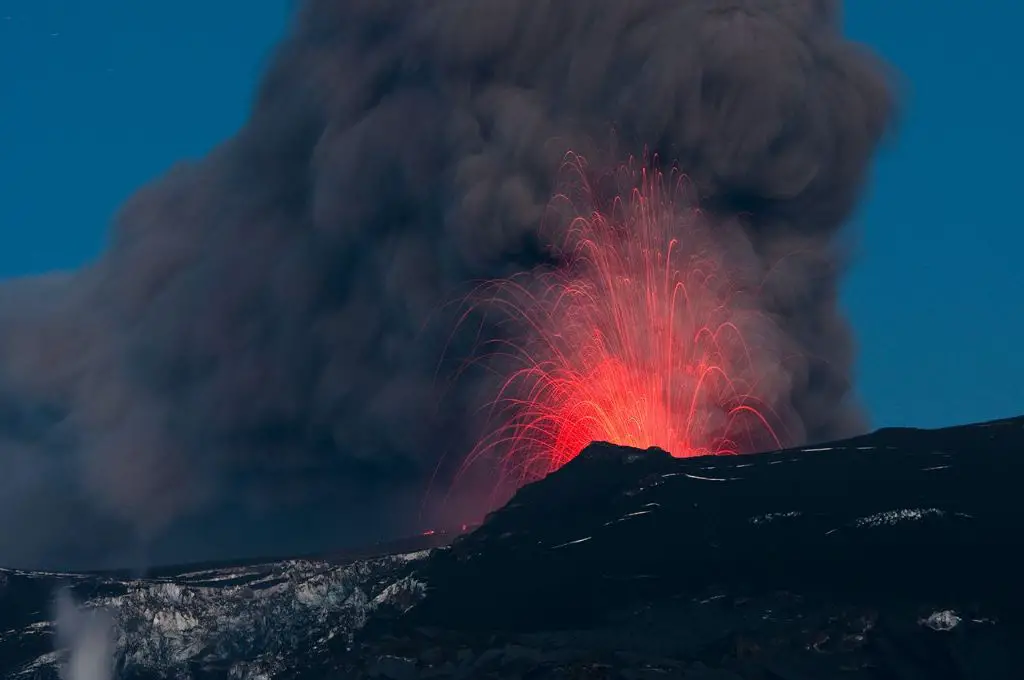How Much Volcanic Ash Per Hour?
What is volcanic ash?
Volcanic ash is made up of fine particles of fragmented volcanic rock that is ejected into the air during volcanic eruptions. According to the National Geographic, volcanic ash is composed of “tiny fragments of jagged rock, minerals, and volcanic glass” that are less than 2 millimeters in diameter.
Composition
The composition of volcanic ash varies depending on the type of volcano and magma. According to the USGS, the most common components of volcanic ash are:
- Pulverized rock (can be new magma or old volcanic rock)
- Glass shards
- Mineral crystals
- Lithic fragments
Other materials found in ash include gases, water vapor, and organic matter from vegetation.
Types
There are several classifications of volcanic ash based on composition and particle size:
- Tephra – airborne volcanic ejecta of any size
- Lapilli – particles 2-64 mm in diameter
- Volcanic blocks – >64 mm in diameter
- Fine ash – <0.06 mm in diameter
- Coarse ash – 0.06-2 mm in diameter
The particle size and shape affects how far the ash can travel and its impacts.
How is volcanic ash produced?
Volcanic ash is produced during explosive volcanic eruptions. Explosive eruptions occur when magma contains abundant dissolved gases, mostly water vapor and carbon dioxide. As the magma rises toward the surface, the decrease in pressure causes the dissolved gases to come out of solution and form bubbles. This increases the overall volume of the magma, resulting in rapid expansion that can fragment the magma into tiny particles that solidify into ash particles as they are ejected into the atmosphere (https://en.wikipedia.org/wiki/Volcanic_ash).

The explosiveness of an eruption, and therefore the amount of ash produced, depends on several factors:
- Magma composition – Felsic magmas like rhyolite contain more dissolved gas and erupt more explosively.
- Ascent rate – Faster ascent provides less time for gas bubbles to escape, increasing explosiveness.
- Magma temperature – Hotter magma can hold more gas, leading to more explosive eruptions.
- External water – Interaction with surface or groundwater can cause violent phreatomagmatic eruptions that produce abundant ash.
In general, stratovolcanoes and composite volcanoes tend to erupt more explosively and generate more ash than shield volcanoes, due to differences in magma composition and vent geometry (https://www.forbes.com/sites/startswithabang/2018/04/23/volcanic-ash-isnt-actually-ash/).
Measuring volcanic ash production
There are several methods used for measuring the amount of volcanic ash produced during an eruption. Direct measurements involve collecting ash samples and weighing them, while indirect methods estimate ash production using observations and models.
The most direct way to measure ash is to physically collect samples during or after an eruption and weigh them. The mass of ash collected from a known area can be extrapolated to estimate total ash production. Samples are often collected using buckets or trays placed around a volcano to catch falling ash. The ash can then be weighed using scales and laboratory equipment (USGS, 2009).
Indirect measurements rely on observations of the eruption plume and models that relate plume height and density to mass eruption rate. The height and density of an ash plume can be estimated using weather radar, satellite imagery, photographs, and visual observations. These plume properties are then input into models like Ash3d developed by the US Geological Survey to estimate the mass eruption rate in units like kilograms per second (USGS Ash3d, 2022).
While direct sample measurements give exact ash amounts, they only represent a small area. Indirect plume models give whole eruption estimates but with higher uncertainty. However, both methods are crucial for understanding ash production from volcanic eruptions.
Factors affecting ash production rates
The amount of volcanic ash produced during an eruption depends on several key factors:
Magma composition – Felsic magma like rhyolite produces more ash than mafic magma like basalt due to higher silica content. Rhyolitic eruptions can generate abundant volcanic ash. [1]
Eruption style and magnitude – Explosive eruptions like Plinian eruptions produce more ash than effusive eruptions like Hawaiian eruptions. Larger, more energetic eruptions generate higher ash volumes. Ash production scales exponentially with eruption magnitude. [2]
Volcano type – Ash production depends on vent position and shape. Central vent volcanoes like composite volcanoes produce more ash than fissure eruptions from rift volcanoes. Narrow vents produce finer-grained ash while wide craters yield coarser ash. [3]
Notable volcanic eruptions
Some of the most notable volcanic eruptions in recent history in terms of ash production include:
Eyjafjallajökull 2010
The 2010 eruption of Eyjafjallajökull in Iceland produced an ash plume that rose to over 9 km and disrupted air travel across Europe for several days [1]. Ash fall extended across Iceland and over much of Northern and Central Europe. The eruption emitted about 250 million cubic meters of ash.
Mt St Helens 1980
The 1980 eruption of Mt St Helens in Washington state produced 1.3 cubic kilometers of ash that fell over an area of 22,000 sq miles [2]. The ash plume rose over 20 km into the atmosphere and encircled Earth in 15 days.
Pinatubo 1991
The 1991 eruption of Mount Pinatubo in the Philippines emitted about 5 cubic kilometers of ash and lowered global temperatures by around 0.5°C for several years. The eruption column reached 40 km and ash fall covered an area of over 22,000 sq km [1].
Impacts of volcanic ash
Volcanic ash can have devastating impacts on the environment, human health, and economic activity. When ash falls to the ground, it blankets everything, causing disruption across wide areas.
Environmental effects include damage to vegetation and agriculture. Ash particles are abrasive and can scrape and damage plant tissues, leading to stunted growth, deformities, and crop failure (National Geographic). Acidic ash can also chemically damage plants and inhibit photosynthesis. Widespread crop loss and destruction of natural vegetation often results.
Ashfall creates major health hazards for people and animals. Fine ash particles irritate respiratory systems and make breathing difficult, especially for those with pre-existing conditions like asthma (IVHHN). Eye and skin irritation are also common. Drinking water sources can become contaminated. Indoor ash can damage HVAC systems and electronics.
Economically, ashfall disrupts transportation networks, aviation, agriculture, and normal business operations. Planes cannot fly through ash clouds, resulting in flight cancellations. Ash cleanup and infrastructure repairs also incur major costs. Wider economic impacts stem from decreased productivity and tourism.
Mitigating volcanic ash hazards
Volcanic ash can cause major disruptions to infrastructure, transportation, agriculture, and human health. There are various strategies used to monitor ash clouds and mitigate potential damage.
Monitoring ash clouds is critical for aviation safety. Volcanic ash advisory centers use satellite data, meteorological models, and ground-based observations to detect ash clouds and forecast their trajectories. This allows officials to issue timely warnings and flight advisories. Aircraft are advised to avoid airspace with ash contamination to prevent engine failure and other impacts. Pre-emptive flight cancellations are often necessary during significant eruptions.
Protecting infrastructure from ash fallout is also important. Roof collapses can result from ash accumulation. Critical facilities like hospitals may install temporary roof reinforcements if ash fall is expected. Water treatment plants can pre-treat water supplies to prevent abrasion from suspended ash particles. Wearing dust masks reduces inhalation hazards for cleanup crews. Regularly clearing ash from roads, railways, and runways helps maintain transport links.
Advance preparations can significantly mitigate ash damage. Identifying vulnerable infrastructure and developing response plans allows for more effective emergency management. Public education campaigns teach communities how to protect themselves during eruptions. While ash impacts cannot be completely prevented, proper monitoring and mitigation measures reduce disruptions and risks.
Volcanic ash applications
Volcanic ash has a variety of practical uses and applications. Some of the most common uses include:
Use as soil additives
Volcanic ash can be an excellent soil additive and fertilizer for agricultural purposes. It contains essential minerals like iron, magnesium, calcium, potassium and silica that plants need to grow. When mixed into soil, volcanic ash increases soil aeration, water retention, and drainage. It also helps neutralize acidic soils. Studies have found crops grown in volcanic ash-enriched soil to be larger and more productive.1
Construction materials
Due to its natural pozzolanic properties, volcanic ash can be used to manufacture concrete, bricks, tiles and other building materials. When mixed with lime and water, volcanic ash forms a cementitious material with binding properties similar to Portland cement. Volcanic ash concrete has good long-term strength and durability, as demonstrated in many ancient Roman structures. Today, volcanic ash is still used as a supplementary cementing material in some modern concretes.2
Cosmetic exfoliants
The abrasive properties of volcanic ash make it useful as an exfoliant ingredient in soaps, scrubs, masks and other cosmetic products. The fine jagged particles can help remove dead skin cells, reduce acne, absorb excess oil, and improve skin texture. However, volcanic ash abrasiveness also means it should be used gently to avoid microtears in skin.3 Overall, volcanic ash offers skin cleansing benefits when used in moderation.
Future Research
There are several areas where additional research on volcanic ash can lead to new discoveries and improvements in mitigating the impacts of ash:
Improving ash measurements – Developing more accurate real-time sensors and modeling to track ash plumes would help predict where ash will travel. This allows for earlier warnings to avoid ash exposure. More precise ashfall measurements are also needed to determine health and environmental impacts.
Modeling ash dispersal – Advanced atmospheric and climate models that better simulate ash dispersal are needed. This can identify areas at highest risk when an eruption occurs. Models should incorporate weather patterns, ash particle sizes, plume height and other factors affecting dispersal.
Understanding health impacts – More research on the long-term respiratory and cardiovascular effects of ash exposure is required, especially at low concentrations. This would improve health guidelines on ash exposure limits and protective equipment needed.
Overall, further multidisciplinary research by volcanologists, atmospheric scientists, health experts and others would lead to breakthroughs in volcanic ash forecasting, mitigation and risk analysis.
Conclusion
Understanding how much volcanic ash is produced by eruptions is crucial for mitigating impacts and hazards. This article has provided an overview of volcanic ash – how it forms during eruptions, methods for measuring ash production rates, factors that affect ash volumes, impacts of ashfall, and ways to analyze ash deposits to reconstruct past eruptions. The key points are:
- Volcanic ash is formed from exploded magma and rock and can travel great distances in the atmosphere.
- Ash production is typically measured in mass per unit time. Real-time monitoring and satellite data allow estimates during eruptions.
- Magma composition, eruption style, column height and weather conditions influence ash volumes.
- Ashfall can disrupt infrastructure, transportation, agriculture and human health over vast areas.
- Ash deposit analysis provides insights into eruption dynamics and supports readiness for future events.
Studying and quantifying ash production will lead to better preparedness and response measures for volcanic eruptions, reducing risks for communities in ashfall zones. Ongoing research and monitoring of active volcanoes is essential for further improving our understanding of these powerful geologic phenomena.




